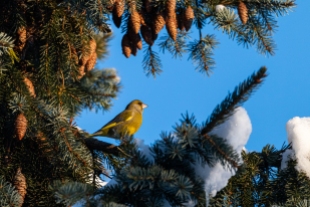This year, we had a full week of “hiihtoloma” (Winter Vacation) – a very welcome break into the busy schedules. I took the opportunity and challenged myself to go out into the nature and look a bit closer at the nature this week.
Firstly, it was interesting to notice that even the “common birds” can provide new experiences and look indeed very different, depending the time of day, weather conditions and particularly light affecting the composition in different manners. Endless opportunities for improvement and experimentation there.
Secondly, during this week I learned to appreciate the winter feeding of birds better. There are people who dedicate countless hours every winter (and indeed considerable sums of money – which some of them have very little) into e.g. forest feeding of wild birds. For many birds this is the only way they can make it through the hardest, coldest parts of the winter alive.
In winter feeding spots it is possible to take photographs of even some rather rare and elusive bird species, if you are patient, stay still and quiet for long periods of time (sometimes in freezing temperatures) and respect the disturbance-free, peaceful environment that such birds require for getting their daily nourishment. Unfortunately it seems that as nature photography is getting increasinly popular, some rare winter birds (such as herons and kingfishers in Finnish winter) attract so many photographers that the huge interest can even endanger the survival of some of these birds. There are only few hours of light and milder cold time every winter day, and the birds need all that time to find the food they need to make it through the next, very cold night. Note though, that no doubt the majority of experienced nature photographers behave responsibly, respect the safe distances, and keep the well-being of the birds as their top priority.
I did not personally visit any sites of such “super rarities” this winter. There was a lot of interesting things to photograph, even without risking the rare ones.
There are many places in Finland, such as our national parks and many hiking areas that have paths that are accessible also in winter time. And when the crust of snow is hard (“hankikeli” is Finnish), one can rather easily walk over marshland or at lake shores, sometimes spotting interesting bird species, but primarily to enjoy the nature and beatiful winter weather. I also visited e.g. Siuronkoski rapids, where white-throated dipper (Cinclus cinclus; koskikara) lives – there is a popular walking path going just next to the rapids, and the birds are so accustomed to humans moving in the area that it is possible to photograph them without disturbing their feeding.
One delightful theme that appeared this week was encountering woodpeckers. There are nine woodpecker species that one can theoretically see in Finland – though some of them are super rare (like Picus viridis). Visiting local forest paths and some winter feeding spots, I managed to photograph four woodpecker species this week, which really delighted me: Dendrocopos major (Käpytikka), Dendrocopos minor (Pikkutikka), Picus canus (Harmaapäätikka) and Dryocopus martius (Palokärki). Previously I had only met the great spotted woodpecker (Dendrocopos major), so this was three new species for me – in just one week. This proves the value of getting our of one’s common paths and trying exploring some new, also less-visited areas every now and then.
The 2nd of March was a particularly excellent day, as it was rather warm, sunny, and we made a longish trip with the entire family, exploring some Pirkanmaa and Satakunta region nature areas together. There were fields where a number of whooper swans (Cygnus cygnus; Laulujoutsen) had already arrived – a sure sign of Spring! While driving home in the evening, we had another surprise encounter: a white-tailed eagle (Haliaeetus albicilla; merikotka), accompanied by an inquisitive and plain greedy crow. These eagles are are the biggest birds of prey in Finland, and also the biggest success story of our nature conservation efforts: in 1973, there was only 35 nesting couples in the entire county, and the species was facing extinction due to chemical pesticides and other factors (in the early 20th century, there was even bounty paid for killing the eagles – and negative attitudes towards birds of prey persisted for a long time). WWF Finland volunteers started winter feeding the eagles, carrying clean and safe meat into islets and rocks where birds could find them, for two decades. Today, it is estimated that there are 450 nesting couples living in Finland. One of the main remaining threats is the use of lead birdshots particularly in Åland islands, leading to lead poisoning of eagles eating carcasses. A third of young eagles continue to die of lead poisoning in Finland every year (see https://yle.fi/uutiset/3-7889294).
To sum up this week of nature experiences: there is so much to see, experience, study and learn in nature – both next door, in one’s own yard or city park, or in the surrounding nature areas. One thing that I became also aware, was that I was using our petrol-powered family car to drive into some of these, more far-away nature locations. I have now started planning of upgrading into an electric vehicle (EV) – but more about that perhaps later. Let’s enjoy and study the nature, responsibly!





























You must be logged in to post a comment.